Humphrey de la Croix
Preface
Because of their specific historical background some used terms in this article need to be explained. In the former colony Netherlands Indies (now Indonesia) people of mixed dutch and indigenous descent were called Indo-Europeans, often briefly called Indos and in English usually named Eurasians. Eddie and Alex van Halen’s mother was an Indo-European and so are her sons Eddie and Alex. Among Indos in the United States Indo-Dutch is a usual term to indicate to Americans their identity and ethnic background. A recent other term for Indos is Amerindo. We noticed this new term is not embraced by everyone within the Indo community in the USA. The editors of this website are now reconsidering it’s use in our publications. At this moment we have not finished the discussion. So, we still mentioned Amerindos.
Indos and music, an almost inseparable combination?
The Amerindo’s are no exception and even have two world-famous musicians who are part of that group. Eddie and Alex van Halen of the rock band Van Halen with the same name, are “thoroughbred” Indos. Their story is that of the American Dream: building a successful life starting from almost (or better: pretty well) nothing. And also in this ’typical’ American way full of romance, glamour and drama.
Indo – Dutch background
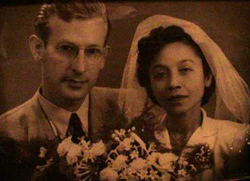
Jan van Halen and Eugenia van Beers married in Indonesia
Photo: Halen.com
Father Jan van Halen was an Amsterdam professional musician (he played saxophone and clarinet). In the thirties of the past century, he and many colleagues did not always have an easy time. They grabbed every opportunity to play, varying from performances in radio orchestras, in circus tents or by enhancing (of: add lustre to) political gatherings. During the German occupation he was arrested for being anti-German, and was interned and employed in Germany. There he was forced to play propaganda music so much hated by him to the honour and glory of the Third Reich. After the war he sought refuge in Indonesia, that, however, became an increasingly Netherlands-hostile place. But for Jan van Halen there was happiness after all these difficult years. He met Eugenia van Beers in Indonesia, his future wife and mother of his sons Eddie and Alex. 1) Eugenia van Beers, an Eurasian of mixed Dutch -Indonesian descent, was born on 21 September 1914 in Rankasbitoeng, district of Lebak in West Java. A place that in fact is only known as the place where writer and critic of dutch colonialism Eduard Douwes Dekker (ps. Multatuli) resided since 1856. Because lack of available resources not much is known about Eugenia’s family background in the Dutch East Indies.
Back to the Netherlands (repatriation)
On 4 March 1953, Jan and Eugenia departed from Jakarta on board the famous repatriants’ ship ‘Sibajak’ to the Netherlands. Not long after they moved into a house in the Michelangelo Street in Amsterdam. Alexander Arthur (Alex) was born on May 8, 1953. Brother Edward Lodewijk (Eddie) followed on January 26, 1955. The musician Jan still had to play wherever he could in the postwar meagre fifties to support his young family. He also had success when he was part of the Ton Wijkamp Kwintet, that won the prestigious Loosdrecht Jazz Competition in 1960.
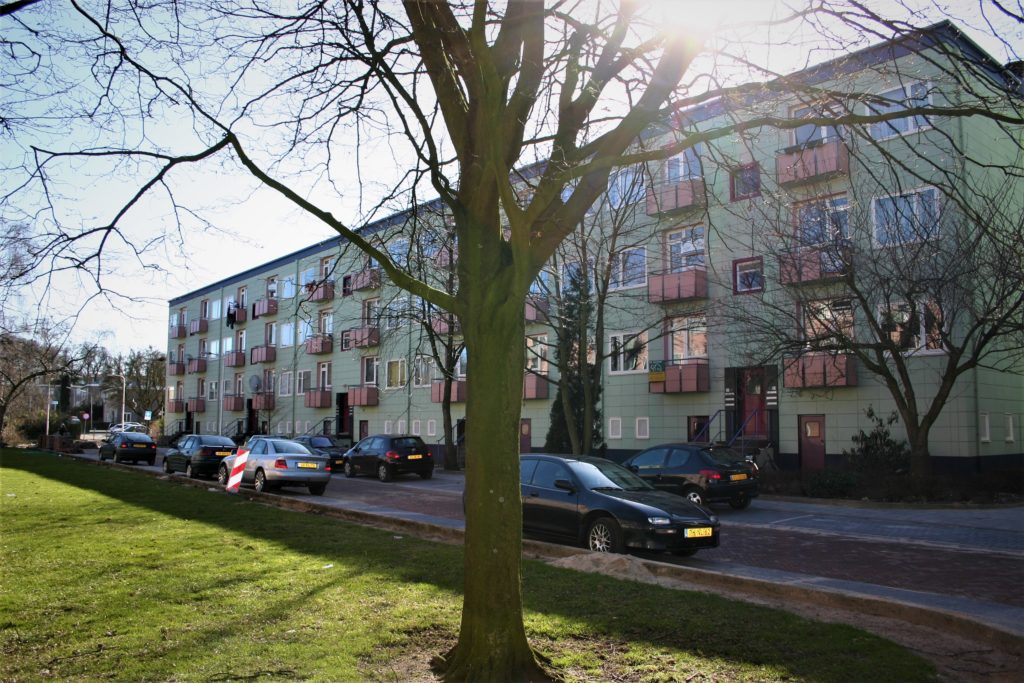
Rozemarijnstraat city of Nijmegen, the Netherlands. At nr. 56 of this after World War II newly built apartment Eddie and Alex van Halen spent som years of their childhood. In 1996 Van Halen was the support act of the Bon Jovi concert in the Nijmegen Goffertpark, only 1 mile away from the Rozemarijnstraat Photo: Humphrey de la Croix 2011
More security came when Jan had the chance to play in the Air Force Band. This was accomodated in the Air Force Instruction and Military Training School (LIMOS) in Nijmegen, where every air force soldier got his basic training. For that purpose, the family moved to Nijmegen shortly after the birth of Eddie and moved into a simple but new porch apartment in the Rozemarijnstraat in the neighbourhood Jerusalem (Nijmegen New West). According to an unconfirmed source, the brothers are said to have visited the building where they had spent their early childhood, when they performed in 1995 (as support act of Bon Jovi) in the local Goffertpark. 2)
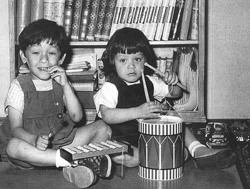
Alex and Eddie as toddler musicians
Photo: Halen.com
To the United States
Influenced by enthusiastic relatives and their stories, Jan van Halen and wife Eugenia decided to emigrate to the United States. The couple eagerly wanted to exchange the harsh conditions in the Netherlands, the bleakness, the rules and the climate for that of California. With only 75 guilders in cash Eddie and Alex entered upon the adventure with their parents. Like many who had preceded them, the trip to New York was made by boat and from there followed a four-day train journey toward the sunshine state California. It is said that during the boat trip, the brothers played music for their fellow passengers. 3)
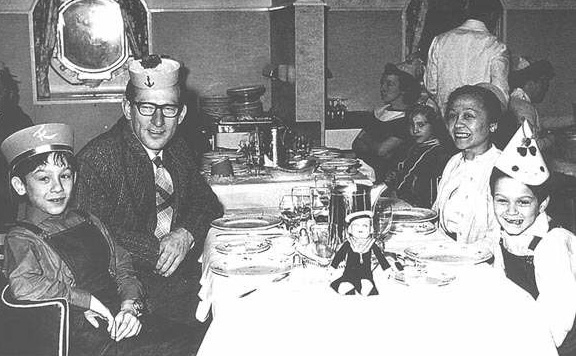
1962. On their way to the United States: Jan van Halen, his wife Eugenia van Beers and their sons Alex and Edward (Eddie)
Photo: Halen.com
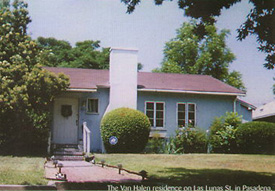
Pasadena, Las Lunas Street. The first house of the Van Halen family and near relatives and friends
Photo: Halen.com
A first adjustment in the United States is that as from now on the name of the family is registered as ‘Van Halen’ instead of in the Dutch way ‘van Halen’. The family ended up in Pasadena, near relatives who had emigrated before them. The family lived in a simple house in Las Lunas Street. Pasadena is a city near Los Angeles with a pleasant climate; in winter the temperature is always around 20 degrees. Family members familiarized the newcomers and helped financially. As was the case with many other immigrants, there was no connecting beautiful job, home and extensive circle of friends and acquaintances in the beginning. Although he was a musician, Jan van Halen was prepared to accept any job he was offered. Wife and mother Eugenia also had the same attitude. Of course, there was not much choice when you had to feed and raise two young sons. For example, mother Eugenia worked as a cleaner and dishwasher in restaurants and hotels for years. Jan van Halen worked, among other things, as a dishwasher in the Methodist Hospital in Arcadia, not far from his Pasadena residence and as a caretaker in the Masonic Temple in Pasadena. In addition, he had his gigs by performing during fairs, parties and the like.4)

2016. Pasadena, Las Lunas Street. The current young resident needed some explanation about the earlier occupants of his house Photo: Humphrey de la Croix 2016
However, the family was close, positive and optimistic. With these qualities, their settling in the US has become successful. The death of their father in 1986 and of their mother in 2005 have been a big blow to Eddie and Alex. It is said that in 1988 the band released the album OU182 in honour of Jan van Halen (‘This one’s for you, Pa’).
At home music was heard all day. Alex says that music was what it was all about. The first memories of music come from his father; also the radio was constantly on. In the US you were already very spoiled in that respect.
When father Jan rehearsed for the Air Force Band at home in Nijmegen, sons Alex and Eddie would have “accompanied” him with the sounds of pans and lids they beat against each other, marching through the living room at the same time. Jan van Halen must have been very happy about this, because it was his dream that his boys would become good and famous musicians one day. It was not for nothing that he had given Eddie the Dutch version of Beethoven’s name as his second name: Lodewijk.5)
Musical education
Alex and Eddie had classical piano lessons for years. In high school, in the late sixties and the early seventies, they naturally came into contact with pop and rock music. The Beatles and the Rolling Stones had been busy for ten years, the flower power was on and there were an awful lot of new musicians and developments in the music. Next to Britain California was the most dynamic place on earth where it all happened.
There was plenty of inspiration: Jerry Garcia and Grateful Dead, The Mamas and the Papas, Joan Baez, Jefferson Airplane, Beach Boys, the Doors, Buffalo Springfield, Jackson Browne, Joni Mitchell, the Byrds, Fleetwood Mac.
The birth of the band
The first band of the brothers was The Broken Combs. After that it became even more serious with their new band Mammoth. Then David Lee Roth, impressed by their performances, came knocking. Roth joined the band as a singer, that from 1974 onwards became Van Halen Band, later simply Van Halen, because another group by the name of Mammoth already existed. By the end of the seventies Van Halen became best known for the flamboyant and innovative guitar-playing of Eddie. In particular, it was the now known as two-hand tapping guitar technique. Here the guitar neck is played quickly with two hands. No less striking were the performances because of the exuberant stage behaviour of David Lee Roth. Rock musicians consider Eddie van Halen as a great guitar-player who has brought innovations in the field of guitar amplification, effects and design. Commercially, it did the band and Eddie in particular no harm.
Success for Van Halen starts in 1978
Just like father Jan van Halen, the band plays as much as possible and they do that in bars, clubs and hotels. Their repertoire is not yet specifically rock and they often play covers. Little by little the band starts to play their own compositions. Their talent does not go unnoticed and the following year the big Warner Bros offers a recording contract. That starts with an untitled first album, with mainly hardrock songs. The debut album has been a success and already after eight months the band got a platinum album. The hit single ‘Running With the Devil’ meant the beginning of their popularity in the Netherlands. The record reached the eighth place in the top 40 charts on 8 May 1980. They have a good relationship with disk jockey Alfred Lagarde, who regularly plugged their music on the radio in VARA’s ‘Betonuur’ (meaning: music hard as concrete and the name of a radio show about metal rock). In that same year the band performs in Amsterdam and in Delft. They can still communicate in Dutch.
Eighties
The next two albums (Van Halen II and Women and Children First) are just as popular and Van Halen is now performing as main act, for example in the Netherlands at the Edenhal in Amsterdam in 1979. The band impresses at the Pinkpop festival in 1980, although they are not willing to cooperate with a live recording for KRO-televison. As a matter of fact, secret recordings are made … The album Fair Warning from 1981 scores somewhat less, but the subsequent Diver Down from 1982, which largely consists of covers, is doing very well. Father Jan van Halen has indirectly fulfilled an honourary role with his clarinet in this album in the song Big Bad Bill (now Sweet William) .8)
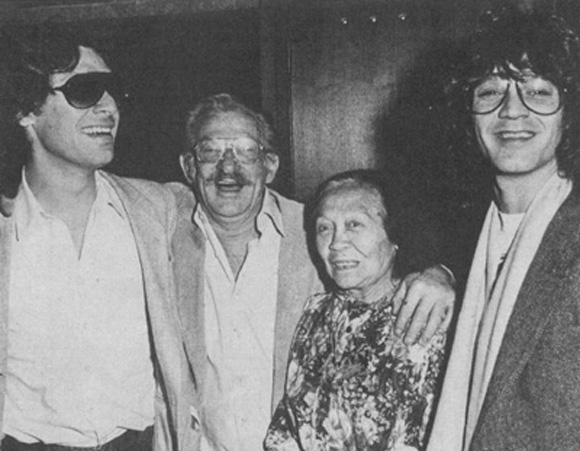
In the eighties Van Halen grew into a main act and the question is whether the band has ever reached the status of superband, despite the successes achieved. Eddie’s extraordinary influence on rock music and on other rock musicians is beyond doubt. Van Halen was a huge box-office success, who in the early days, as a supporting act sometimes almost outshone the main act. The status of the band is best illustrated with the example of their performance in 1996 in Nijmegen as support act for Bon Jovi. The latter has been one of the super rock bands in the world for over 25 years.
Eddie achieved personal successes due to his innovative guitar- playing and innovative ideas for guitar designs. He had a guest appearance with Michael Jackson to perform his hit Beat it together. The colleagues from the rock scene appreciate him undiminishedly. This irritated singer David Lee Roth who struggled with reduced attention.
There was not only success. A number of dramatic events followed in the mid-1980s. In the band, the irritations about David Lee Roth led to his departure in 1985. Despite the fear of a relapse, his departure did not harm the success and development of Van Halen as a band. But the death of their father Jan van Halen in 1986 had a deeper impact on the brothers. Their source of inspiration and above all good and loving father was no longer there. Although coming from a completely different musical tradition, he had no trouble with the choices of his sons. To what extent it was a close (Indo?) family cannot be judged from the outside, but judging from some casual statements of both brothers they came from a warm, secure and closely-knit nest. Sammy Hagar replaced Roth and the album 5150 (1986) with him as a singer is a great success. The music has become more mainstream: less hard rock, slightly more pop sound. The next album that was released was OU812 (1988), which can be seen as a tribute to Jan van Halen.
From the nineties to the present
At that time Van Halen is much less heard and seen in Europe. In the Netherlands there is still a good number of loyal fans. There are performances such as the previously mentioned support act for Bon Jovi in Nijmegen in 1996. You can still find ’transnationalist’ traces with the brothers. They still speak Dutch, but with a broad Yankee accent. Please watch an interview with Eddie on YouTube. Eddie’s personal life has been more tempestuous since the nineties. It started so well with the birth of his son Wolfgang in 1991. With this name (Mozart) following the example of his father who had named him after Van Beethoven. Wolfgang is now bass player at Van Halen. But Eddie also struggled with an alcohol addiction. In 2001 he got cancer, from which he recovered in 2002. The Van Halen band did not perform together anymore after 2004, but in 2007 they announced to be going on tour again with ….. David Lee Roth as their singer. The total of 37 performances are all successful. In 2011 Van Halen announced to go on tour again. The current line-up: David Lee Roth, Alex, Eddie and
his son Wolfgang Van Halen.
Epilogue
The story of the Van Halen family is an example of successful Amerindos. Of course it is not an average history, but is definitely one of second generation migrant children who made it. Father Jan and mother Eugenia did have the typical starting problems like not having a beautiful job, a house and social success rightaway. It is a personal story of drudging, persevering and eventually succeeding in becoming a US citizen. Together, the Van Halens formed a close and warm family.
A typical Indo Dutch family?
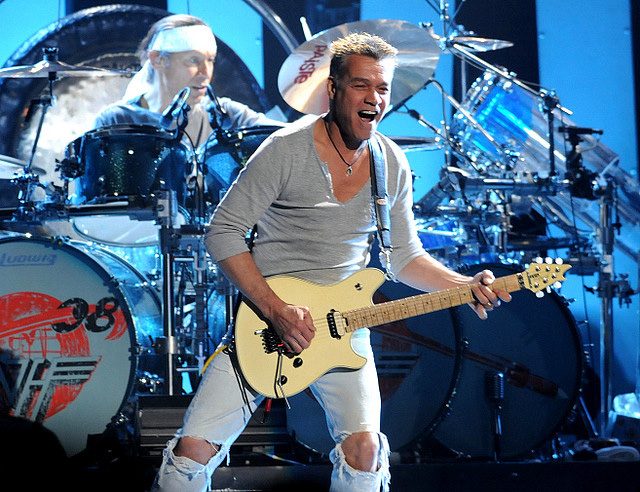
Alex en Eddie van Halen in 2008
Photo: © Taylor Player
Article translated by Inge Dümpel, editor of www.indischhistorisch.nl
____________________________
Notes
1) Wikipedia
2) Dutch Van Halen website en Het Nederlandse Van Halen Forum
3) Ibidem
4) C. J. Chilvers, The Van Halen Encyclopedia, p. 223.
5) Dutch Van Halen website
6) Ibidem.
7) Dutch Van Halen website
8) Ibidem.
9) Wikipedia
Literature
C. J. Chilvers, The Van Halen Encyclopedia, Oak Lawn (Il)1999.
Dutch Immigrants to the United States: Gerard Kuiper, Eddie Van Halen, Barthold Fles, Daniel de Leon, Colonel Tom Parker, Willem de Kooning, 2010.
Internet
https://en.wikipedia.org/wiki/Indo_people
https://myindoworld.com/
http://krancher.org/indos.html
http://www.van-halen.com/
http://www.vhnd.com/
https://en.wikipedia.org/wiki/Van_Halen
http://ultimateclassicrock.com/tags/van-halen/
http://www.bigwowo.com/2012/03/eddie-and-alex-van-halen-talk-about-their-indonesian-mothers-influence/
